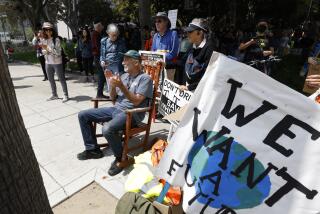OLDER AMERICANS COMING UP FOR AIR TIME
- Share via
America has such a youth tilt that it was a major story when “Dynasty” star Linda Evans admitted being past 40.
She was toasted for having the courage to reveal her advanced age. Not only that, she was also still beautiful, walked without a cane and could remember her own name. Astonishing! No wonder the nation’s other 40-year-olds found her so inspirational.
Forty.
If America has been conditioned to think of middle age as old age, then what must America think about the post-65 crowd?
“The perception is that after 65, you are a leftover,” said Marshall Frady recently. And when others continually define you as passe, Frady added, that becomes a self-fulfilling prophecy and you believe it yourself.
Frady, whose father is a 76-year-old Baptistpreacher in Augusta, Ga., is principal writer for “Growing Old in America,” Saturday’s (8 p.m. on Channels 3, 7 and 10) shocking, highly critical and acutely painful three-hour ABC News “Closeup” documentary that deserves--demands--a wide audience.
“For a long time, this has been a culture of the new, the fresh and the dispatchable,” said Frady, a skilled writer and one of TV’s very best journalists. “To be old is to be un-American.”
Frady said he approached “Growing Old in America” with his own prejudices, thinking it would be “very depressing” for anyone to sit through a documentary about aging in a nation that pushes its aged to the back of the bus. But he changed his mind after witnessing the talent, strength and vigor of so many older Americans.
These are not three hours of happy times, however. Hosted by Hugh Downs, much of “Growing Old in America” is grim. It is also important, a powerful and dramatic indictment of a system ill-suited, unprepared, shortsighted and largely disinterested when it comes to caring for its oldest citizens.
There is continuing age discrimination in America, including mandatory retirement in areas not under federal guidelines. Too often, Downs says, the message to older Americans is: “Move out of the way!” And that message is reinforced by public policy.
Americans are retiring younger and living longer but facing an uncertain future, we’re told, in a nation where Social Security is the largest part of the incomes of 65% of the elderly. Yet the average annual Social Security payment is only $5,400.
The nation is unprepared for a future in which the over-65 community will outnumber the 18-to-34 population by the year 2030, Downs says. And America is also unprepared for the present, sometimes preferring to soften unpleasant reality with deceptive statistics. According to Downs, 263,000 older workers were removed from this year’s unemployed rolls simply because they gave up searching for jobs.
The program also attacks the “sick, senseless and senile” myth about the elderly. Most elderly Americans “are winning the battle against disability,” Downs says. But for those who aren’t, life can be a horror.
We see a medical community largely unequipped and untrained to accommodate the nation’s swell of elderly patients. We see families wiped out by enormous medical bills, elderly patients whose legacies are hospital debts. All this occurs against a background of threatened health-care reductions by the Reagan Administration, Downs says.
We also see the older person’s fear of dependence and lost control, the specter of the nursing home looming more ominously even than death.
It is a sad story, made even sadder, unfortunately, by an oppressive, almost funereal musical background that sometimes seems to change the tone of the accompanying words and pictures. This unwise intrusion is the only major flaw in an otherwise masterwork documentary that should be mandatory viewing for Americans of all ages.
This is the latest in a series of three-hour “Closeup” documentaries--including the brilliant “To Save Our Schools, to Save Our Children” and “The Fire Unleashed”--that, ironically, may face as uncertain a future as the subjects of “Growing Old in America.” The “Closeup” staff has been trimmed as part of ABC’s cost cutting before the network’s coming takeover by Capital Cities Communications Inc. And the valuable Frady, who was on-screen reporter for past “Closeup” documentaries, himself may be leaving the unit. He was replaced as on-screen reporter for the present documentary (after having taped part of the narration) by “20/20” anchorman Downs, reflecting ABC’s desire to give more visibility to its news anchors.
Meanwhile, the plight of some of America’s elderly continues with no help in sight. On the screen are bed-ridden, suffering, despondent and helpless citizens whose needs have been largely forgotten by their own countrymen. And you wonder. . . .
In 10, 20, 30 or 40 years, will that be you?
More to Read
The complete guide to home viewing
Get Screen Gab for everything about the TV shows and streaming movies everyone’s talking about.
You may occasionally receive promotional content from the Los Angeles Times.






